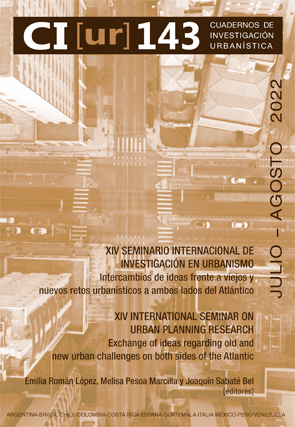Geografías del conflicto, geometrías de la percepción: una propuesta metodológica para mapear la opinión de un territorio = Geographies of conflict, geometries of perception: A methodological proposal for mapping the opinion of a territory
DOI:
https://doi.org/10.20868/ciur.2022.143.5008Palabras clave:
Conflicto urbano, Análisis mediático, Valor semántico del territorio, Camp de Tarragona, Urban conflict, Media analysis, Semantic value of the territoryResumen
Resumen
Esta investigación parte de la voluntad de detectar y caracterizar los lugares del conflicto urbano que han protagonizado las tres últimas décadas de desarrollo de la ciudad de Tarragona. Para ello, este ensayo parte de la observación sistematizada y crítica del relato mediático de la prensa escrita para identificar, acotar y examinar aquellos ámbitos geográficos donde colidan, con mayor o menor virulencia, las carencias, nostalgia, resistencia al cambio y expectativas de transformación. Son los lugares donde compiten múltiples intereses, a menudo contradictorios, por orientar el devenir urbano, espacios donde toman cuerpo los designios abstractos del mercado inmobiliario y las contestaciones, resistencias y fricciones derivadas. Son también los escenarios del error, el exceso, el infortunio o la obsolescencia y abandono. En todos ellos, el conflicto urbano puede actuar como motor del cambio y principio catalizador de transformación o, por el contrario, como condena a la parálisis eterna. El análisis sistemático de la hemeroteca local y la ponderación de variables como el momento, el grado de impacto, el sentimiento asociado a cada noticia o los ámbitos referentes emerge, pues, como estrategia innovadora para estructurar un hilo argumental de la biografía, geometría y geografía de los principales hechos urbanos de cualquier realidad metropolitana contemporánea.
Abstract
This research is based on the desire to detect and characterize the places of urban conflict that have played the leading roles of the last three decades of development in the city Tarragona. To do so, this essay starts from the systematized and critical observation of the media narrative of the written press to identify, delimit and examine those geographical areas where, with greater or lesser virulence, deficiencies, nostalgia, resistance to change and expectations of transformation collide. They are the places where multiple interests, often contradictory, compete to guide the urban future, spaces where the abstract designs of the real estate market and the resulting disputes, resistances and frictions take shape. They are also scenarios of error, excess, misfortune or obsolescence and abandonment. In all of them, the urban conflict can act as a motor and a catalyst for change or, on the contrary, as a sentence to eternal paralysis. Thus, the systematic analysis of the local newspaper archive and the weighting of variables such as the moment, the impact degree, the sentiment associated with each piece of news or the relevant areas emerges as an innovative strategy to structure a plot line of biography, geometry and geography of the main urban facts of any contemporary metropolitan reality.
Descargas
Referencias
Anderson, J., L. O'Dowd (1999). Borders, Border Regions and Territoriality: Contradictory Meanings, Changing Significance. Regional Studies 33(7). https://doi.org/10.1080/00343409950078648
Blank, G, Graham, M, Calvino, C (2017). Local geographies of digital inequality. Social Science Computer Review 36(1). https://doi.org/10.1177/0894439317693332
Bollens, S. (2012). City and Soul in Divided Societies. Londres & Nueva York: Routledge.
Clément, G. (2003). Le Tiers Paysage. París: Editions Sujet/Objet
Corboz, André. (1985) Il territorio come palimsesto. Casabella, 516.
Coward, M. (2009). Urbicide. The Politics of Urban Destruction. Londres & Nueva York: Routledge.
De Solà-Morales, I. (1995). Terrain Vague. Anyplace. Anyone Corporation, 118(23).
Dodge, M. (2018). Mapping II: News media mapping, new mediated geovisualities, mapping and verticality. Progress in Human Geography, 42(6). https://doi.org/10.1177/0309132517733086
Elwood, S., Leszczynski, A. (2013). New spatial media, new knowledge politics. Transactions of the Institute of British Geographers 38(4). https://doi.org/10.1111/j.1475-5661.2012.00543.x
Griffin, A.L., Robinson, A.C., Roth, R.E. (2017). Envisioning the future of cartographic research. International Journal of Cartography. https://doi.org/10.1080/23729333.2017.1316466
Hepburn, A. C. (2004). Contested Cities in the Modern West. Basingstoke: Palgrave Macmillan
Hirst, P. (2005). Space and Power. Politics, War and Architecture. Cambridge & Malden: Polity Press.
Huyssen, A. (2003). Present Pasts: Urban Palimpsests and the Politics of Memory. Stanford: Stanford University Press.
Jordan, J. (2006). Structures of Memory. Understanding Urban Change in Berlin and Beyond. Stanford: Stanford University Press.
Kitchin, R., Lauriault, T.P., Wilson, M.W. (2017). Understanding Spatial Media. Londres: SAGE. https://dx.doi.org/10.4135/9781526425850.n1
Kurgan, L. (2017). Conflict urbanism, Aleppo: Mapping urban damage. NY: Architectural Design 87(1). https://doi.org/10.1002/ad.2134
Naik, N., Kominers, S.D., Raskar, R., Glaeser, E.L., Hidalgo, C.A. (2017). Computer vision uncovers predictors of physical urban change. Proceedings of the National Academy of Sciences 114(29). https://doi.org/10.1073/pnas.1619003114
Pullan, W. (2013). Conflict's Tools. Borders, Boundaries and Mobility in Jerusalem's Spatial Structures. Mobilities 8(1). https://doi.org/10.1080/17450101.2012.750040
Sibley, D. (1995). Geographies of Exclusion: Society and Difference in the West. Londres: Routledge.
Sui, D.Z., Goodchild, M.F. (2001). GIS as media? International Journal of Geographical Information Science 15(5). https://doi.org/10.1080/13658810110038924
Schulz-Dornburg, J. (2012). Ruinas modernas, una topografía del lucro. Barcelona: Àmbit.
Weizman, E. (2017). Forensic Architecture: Violence at the Threshold of Detectability. Cambridge, MA: MIT Press.
Williams, S. (2020). Data Action. Using data for public good. Cambridge & Londres: The MIT Press.
Wilmott, C. (2017). In-between mobile maps and media: Movement. Television & New Media 18 (4).












